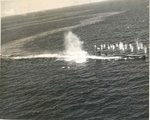Could strafing with .50 cal alone sink or disable a sub? I'm sure it would chew it up enough to end its voyage but could it disable or sink a sub - allied or axis?
20mm?
20 mm is low velocity it seems like it would just explode on the skin..
World War 2 Pictures In Color :: The Best of Black and White WWII Photos :: uboat_strafe
.
20mm?
20 mm is low velocity it seems like it would just explode on the skin..
World War 2 Pictures In Color :: The Best of Black and White WWII Photos :: uboat_strafe
.

